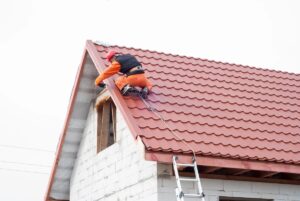Top 5 Signs Your Roof Needs Repair: Don’t Ignore These Warning Signals
Your roof is one of the most critical components of your home, providing shelter and protection from the elements. Over time, wear and tear can lead to damage that, if left unchecked, may result in costly repairs or even a full replacement. Identifying the early warning signs of roof trouble can save you money and prevent further damage to your home. Here are some key indicators that your roof may need attention.
Water Stains and Leaks Inside Your Home
 One of the most noticeable signs of roof damage is water stains on your ceiling or walls. These stains may appear as dark patches or streaks and often indicate a roof leak. In some cases, you may even notice water dripping during heavy rain. Leaks can result from damaged shingles, flashing issues, or poor roof ventilation. Even small leaks can lead to mold growth, structural damage, and weakened insulation if not addressed promptly.
One of the most noticeable signs of roof damage is water stains on your ceiling or walls. These stains may appear as dark patches or streaks and often indicate a roof leak. In some cases, you may even notice water dripping during heavy rain. Leaks can result from damaged shingles, flashing issues, or poor roof ventilation. Even small leaks can lead to mold growth, structural damage, and weakened insulation if not addressed promptly.
Missing, Cracked, or Curling Shingles
Shingles play a crucial role in protecting your roof from the elements. Over time, they can become damaged due to exposure to wind, rain, and extreme temperatures. If you notice shingles that are missing, cracked, or curling at the edges, your roof may be vulnerable to leaks and further deterioration. Aging roofs often lose their protective granules, making them more susceptible to damage. Regular inspections can help identify these issues before they lead to more significant problems.
Sagging or Uneven Rooflines
A sagging or uneven roofline is a serious sign of structural damage. This issue may be caused by prolonged exposure to moisture, weakening the roof’s support structure. Water damage, poor installation, or excessive weight from snow and debris can also contribute to sagging. If you notice any dips or uneven areas in your roof, it is essential to have a professional roof repair inspection to determine the extent of the damage and prevent potential collapse.
Moss, Algae, and Mold Growth
 The presence of moss, algae, or mold on your roof may seem like a minor cosmetic issue, but it can indicate deeper problems. Moss retains moisture, which can lead to the gradual deterioration of shingles and wood beneath. Algae and mold thrive in damp environments and can contribute to roof decay. If left untreated, these growths can compromise your roof’s integrity and shorten its lifespan. Regular cleaning and proper roof ventilation can help prevent moisture buildup and the resulting damage.
The presence of moss, algae, or mold on your roof may seem like a minor cosmetic issue, but it can indicate deeper problems. Moss retains moisture, which can lead to the gradual deterioration of shingles and wood beneath. Algae and mold thrive in damp environments and can contribute to roof decay. If left untreated, these growths can compromise your roof’s integrity and shorten its lifespan. Regular cleaning and proper roof ventilation can help prevent moisture buildup and the resulting damage.
Higher Energy Bills and Poor Insulation
A well-maintained roof helps regulate your home’s temperature by providing adequate insulation. If your energy bills have been rising without explanation, it may be a sign that your roof is no longer performing efficiently. Poor insulation or damage to the roof’s structure can allow heat to escape in the winter and enter in the summer, forcing your heating and cooling systems to work harder. Addressing roof issues can improve energy efficiency and reduce your monthly expenses.
